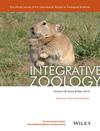蜱虫感染虫媒病毒并将其传播给脊椎动物宿主的潜在机制。
IF 3.5
1区 生物学
Q1 ZOOLOGY
引用次数: 0
摘要
蜱虫可将包括虫媒病毒在内的多种病原体传播给脊椎动物宿主。虫媒病毒在从蜱肠道进入宿主皮肤的血淋巴、唾液腺和取食部位的过程中,必须克服或躲避防御机制。本综述总结了目前关于蜱虫特定组织和宿主皮肤取食部位的防御机制的知识。我们将讨论这些防御机制在病毒感染和传播中可能发挥的作用。此外还讨论了蜱唾液蛋白对虫媒病毒感染的反应。这篇综述提供的信息可能有助于加快病毒与蜱虫相互作用的研究。本文章由计算机程序翻译,如有差异,请以英文原文为准。
Potential mechanisms implied in tick infection by arboviruses and their transmission to vertebrate hosts.
Ticks can transmit many pathogens, including arboviruses, to their vertebrate hosts. Arboviruses must overcome or evade defense mechanisms during their passage from the tick gut to the hemolymph, salivary glands, and the feeding site in the host skin. This review summarizes current knowledge of defense mechanisms in specific tick tissues and at the feeding site in the host skin. We discuss the possible roles of these defense mechanisms in viral infection and transmission. The responses of tick salivary proteins to arbovirus infection are also discussed. This review provides information that may help accelerate research on virus-tick interactions.
求助全文
通过发布文献求助,成功后即可免费获取论文全文。
去求助
来源期刊

Integrative zoology
ZOOLOGY-
CiteScore
6.40
自引率
12.10%
发文量
81
审稿时长
>12 weeks
期刊介绍:
The official journal of the International Society of Zoological Sciences focuses on zoology as an integrative discipline encompassing all aspects of animal life. It presents a broader perspective of many levels of zoological inquiry, both spatial and temporal, and encourages cooperation between zoology and other disciplines including, but not limited to, physics, computer science, social science, ethics, teaching, paleontology, molecular biology, physiology, behavior, ecology and the built environment. It also looks at the animal-human interaction through exploring animal-plant interactions, microbe/pathogen effects and global changes on the environment and human society.
Integrative topics of greatest interest to INZ include:
(1) Animals & climate change
(2) Animals & pollution
(3) Animals & infectious diseases
(4) Animals & biological invasions
(5) Animal-plant interactions
(6) Zoogeography & paleontology
(7) Neurons, genes & behavior
(8) Molecular ecology & evolution
(9) Physiological adaptations
 求助内容:
求助内容: 应助结果提醒方式:
应助结果提醒方式:


